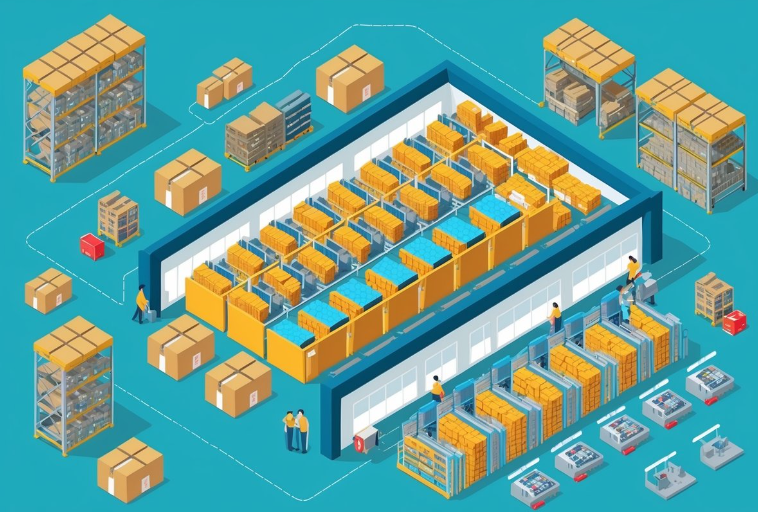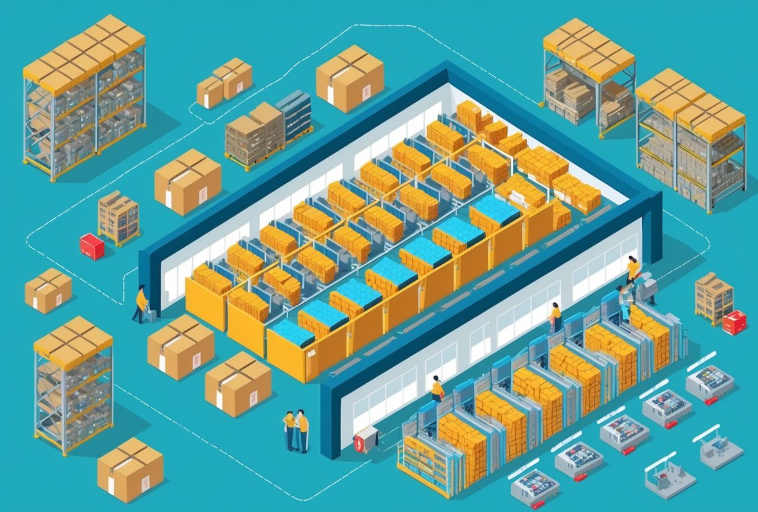A Complete Guide to Streamline Your Shipping Operations

Shipping operations that run smoothly can be the difference between growth and stagnation for your e-commerce business. When your products move efficiently from shelf to doorstep, you build customer loyalty that drives repeat business. However, when delays, errors, and miscommunications occur, even loyal customers begin looking elsewhere.
At Innovative Warehouse Solutions, we help small to mid-sized brands overcome logistics challenges with a personalized approach that larger 3PLs simply can’t match. Our transparent pricing and real-time support allow you to focus on creating more orders—we’ll handle getting them to your customers.
Understanding Shipping Operations
Efficient logistics form the backbone of successful e-commerce businesses. Let’s explore what this entails and why it matters so much for your bottom line.
Definition of Shipping Operations
Shipping operations include all activities related to preparing and delivering products from your business to customers. This process ranges from order processing and inventory management to packaging, labeling, carrier selection, and delivery tracking.
For e-commerce businesses, particularly those in health and beauty, consumer goods, and beverage industries, shipping operations typically include:
- Small parcel shipping: Individual packages sent directly to consumers
- Freight shipping: Larger shipments sent between businesses or from manufacturers to retailers
These processes require close coordination between your shipping department, warehouse staff, and external partners to ensure products reach customers accurately and on time.
Importance of Shipping Operations in E-commerce
The quality of your delivery processes directly affects customer satisfaction and retention. In today’s market where consumers expect both speed and accuracy, your shipping experience often determines whether a customer returns.
Research shows that 84% of shoppers won’t return to a brand after a poor delivery experience. Moreover, well-managed shipping processes contribute to:
- Lower operating costs
- Better inventory control
- Higher customer satisfaction ratings
- Increased repeat purchases
- Improved reviews and referrals
When your shipping runs smoothly, you create the kind of reliability that builds lasting customer relationships.
Key Components of Shipping Operations
A well-functioning shipping system consists of several interconnected stages that work together to ensure accurate, timely delivery:
- Order Receiving: The process begins when a customer orders, triggering payment verification and order record creation.
- Order Processing: Your team validates order details, checks inventory availability, and prepares documentation.
- Fulfillment: Products are picked from warehouse shelves, inspected for quality, and packaged appropriately.
- Shipping: Packages are labeled, carrier services are selected, and parcels are dispatched for delivery.
- Tracking and Communication: Updates about package status and estimated delivery times are shared with customers.
When these elements are properly integrated, they create a seamless flow that meets customer expectations while minimizing your operational burden.
Key Responsibilities in Shipping Operations
Understanding the core responsibilities in shipping operations helps businesses make informed decisions about internal management versus partnering with a specialized 3PL. These critical functions include:
- Stakeholder Coordination: Building relationships with carriers, warehouses, customs officials, and supply chain partners to ensure seamless operations.
- Voyage Management: Planning optimal routes, monitoring shipment progress, and making real-time adjustments when disruptions occur.
- Financial Supervision: Manage all cost aspects, including carrier rates, fuel surcharges, customs duties, and insurance, with complete billing clarity.
- Cargo Handling: Ensuring proper preparation, packaging, labeling, and loading of merchandise to prevent damage and maintain compliance.
- Documentation Management: Preparing and processing customs declarations, bills of lading, commercial invoices, and other required paperwork.
- Port Activities: Coordinating loading and unloading schedules and navigating complex customs procedures at various ports.
- Post-Shipment Support: Providing real-time assistance after shipping arrangements are made, including order tracking and issue resolution.
For businesses in health and beauty, beverage, and consumer goods, dedicating internal resources to manage these complex responsibilities often pulls focus from product development, marketing, and sales. This operational burden becomes incredibly challenging for companies with 2-10 employees aiming to scale beyond $1M in annual revenue.
Strategies for Optimizing Shipping Operations

Now that we understand the fundamentals let’s explore practical strategies to enhance efficiency and customer satisfaction.
Utilizing Automation
Automation improves shipping operations by reducing manual workload, minimizing errors, and increasing processing speed.
Key automation opportunities include:
- Order Management Systems: Process orders from multiple sales channels automatically, reducing data entry errors.
- Pick-to-Light Systems: Guide warehouse staff to correct inventory locations, improving picking accuracy by up to 99.9%.
- Barcode Scanning: Verify products against orders with simple scans, reducing shipment errors.
- Automated Packaging Solutions: Determine optimal package sizes and materials, reducing waste and shipping costs.
Even basic automation can significantly improve warehouse-to-warehouse delivery efficiency. Our software solutions integrate these tools into your existing operations with minimal disruption, allowing you to maintain focus on your core business.
Implementing a Warehouse Management System
A Warehouse Management System (WMS) serves as the central command center for your shipping operations, coordinating inventory, personnel, and equipment to maximize efficiency.
An effective WMS offers:
- Real-time Inventory Visibility: Know precisely what’s in stock and where it’s at all times.
- Labor Management: Track productivity and identify opportunities for training and improvement.
- Reporting and Analytics: Generate insights into shipping performance, bottlenecks, and cost drivers.
- Integration Capabilities: Connect with your e-commerce platform, accounting software, and shipping carriers.
For luxury brands and retailers of high-value products, white glove fulfillment features can be integrated into your WMS to ensure premium items receive the specialized handling they deserve, enhancing customer satisfaction and reducing damage claims. Our integrations work with popular e-commerce platforms, making implementation straightforward for businesses with limited IT resources.
Partnering with Reliable Shipping Carriers
The carriers you select directly impact delivery times, shipping costs, and customer satisfaction. Strategic carrier partnerships can help your delivery warehouse operations become a competitive advantage rather than a liability.
When evaluating potential carrier partners, consider:
- Service Coverage: Ensure carriers deliver consistent service to all your customer locations.
- Delivery Speed Options: Different shipping speeds to meet customer expectations and price points.
- Tracking Capabilities: Select carriers with comprehensive tracking systems that integrate with your order management platform.
- Reliability Metrics: Research on-time delivery percentages and package handling quality.
- Pricing Structure: Look beyond base rates to understand accessorial charges, fuel surcharges, and volume discounts.
Many successful e-commerce businesses in health and beauty, beverage, and consumer goods industries use a multi-carrier strategy, selecting different services based on package characteristics, destination, and delivery timeline requirements. This approach provides flexibility while keeping costs manageable.
Strategic Inventory Distribution
Distributing inventory across multiple locations can dramatically reduce shipping times and costs, especially as your business grows beyond 300 monthly orders.
Benefits of strategic inventory distribution include:
- Reduced Shipping Distances: Position products closer to customer concentrations.
- Lower Shipping Costs: Shorter distances mean lower carrier fees.
- Faster Delivery Times: Meet customer expectations for quick delivery without premium shipping rates.
- Risk Mitigation: Reduce vulnerability to regional disruptions or facility issues.
To implement effective inventory distribution:
- Analyze customer location data to identify regional demand patterns
- Consider seasonal variations in purchasing behavior
- Balance inventory holding costs against shipping savings
- Establish transparent processes for inventory transfers between locations
For businesses not ready to manage multiple facilities, partnering with a customer-focused 3PL like Innovative Warehouse Solutions offers access to distributed warehouse networks without capital investment and operational complexity.
Practical Tips for Reducing Shipping Costs
Even small optimizations in your shipping operations can yield significant cost savings without sacrificing the quality that builds customer loyalty:
- Package Optimization: Right-size packaging to reduce dimensional weight charges and materials costs.
- Rate Shopping: Compare carrier rates for each shipment to find the most cost-effective option.
- Consolidation: Combine multiple orders going to nearby locations when possible.
- Negotiate Volume Discounts: Use your shipping volume to secure better rates from carriers.
- Small Parcel Management Strategies: can significantly reduce costs when implemented systematically across your shipping operations.
- Address Verification: Implement systems to correct address errors before shipment, avoiding costly rerouting.
- Prepaid Return Labels: Include return labels with outbound shipments to secure lower return shipping rates.
While controlling costs is important, balance savings against service quality. The most affordable shipping option isn’t always the best for your brand reputation and customer satisfaction. At IWS, we help you make these decisions with complete billing transparency—no hidden fees or unexpected charges.
Shipping Operations FAQs
What is the role of a shipping operations specialist?
A shipping operations specialist manages logistics, coordinates shipments, ensures regulatory compliance, and optimizes supply chain efficiency. They oversee scheduling, documentation, and carrier communication to ensure timely and cost-effective deliveries.
What are the operational risks of shipping?
Operational risks in shipping include delays, cargo damage, theft, regulatory violations, and environmental hazards. Other risks include labor disputes, equipment failures, and cybersecurity threats affecting logistics and tracking systems.
What is the shipping process?
The shipping process involves order processing, packaging, labeling, documentation, carrier selection, transit, customs clearance, and final delivery. Each step ensures accurate, efficient, and secure transportation of goods.
What are the responsibilities of shipping and receiving?
Shipping and receiving personnel manage incoming and outgoing shipments, inspect goods for accuracy and damage, handle inventory updates, and coordinate with carriers to ensure timely deliveries.
What is a shipping operation executive?
A shipping operation executive oversees transportation logistics, negotiates freight rates, manages vendor relationships, and ensures compliance with shipping regulations. They focus on optimizing costs and improving supply chain efficiency.
Conclusion
Effective shipping operations represent a critical competitive advantage in today’s e-commerce landscape. By implementing the strategies outlined above, businesses can create shipping experiences that delight customers while maintaining healthy margins.
Remember that optimizing shipping operations is an ongoing process that requires consistent attention and refinement. As your order volume grows, the complexity of your shipping operations will increase—often at a faster rate than your team can manage while still focusing on product development, marketing, and sales.
For health and beauty, beverage, and consumer goods brands looking to improve their shipping operations without managing the complexity internally, consider how a partnership with IWS can help. Our real-time, personalized customer support stands out in an industry known for impersonal service, ensuring your questions are answered promptly and your customers receive exceptional delivery experiences.
Learn how our fulfillment services can help you focus on growing your business while we handle the operational challenges of getting your products to customers quickly and accurately. Contact us today for a consultation about your specific shipping needs.


